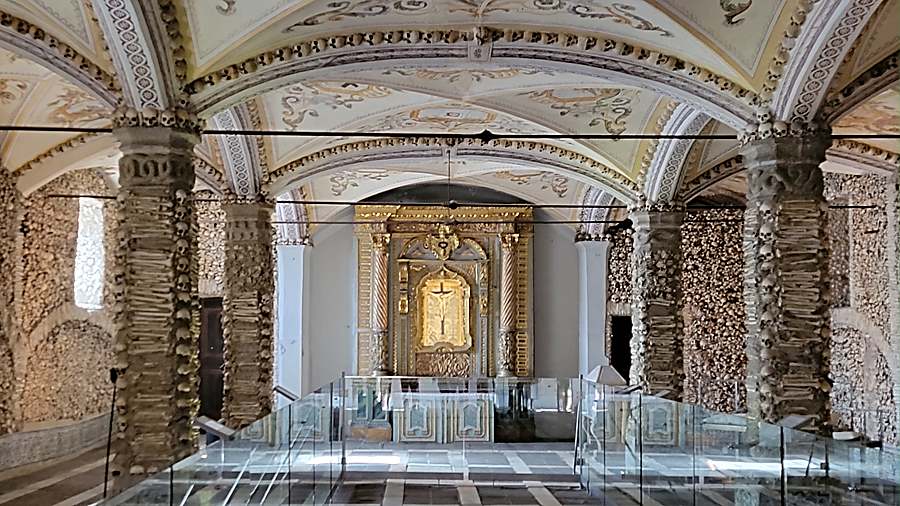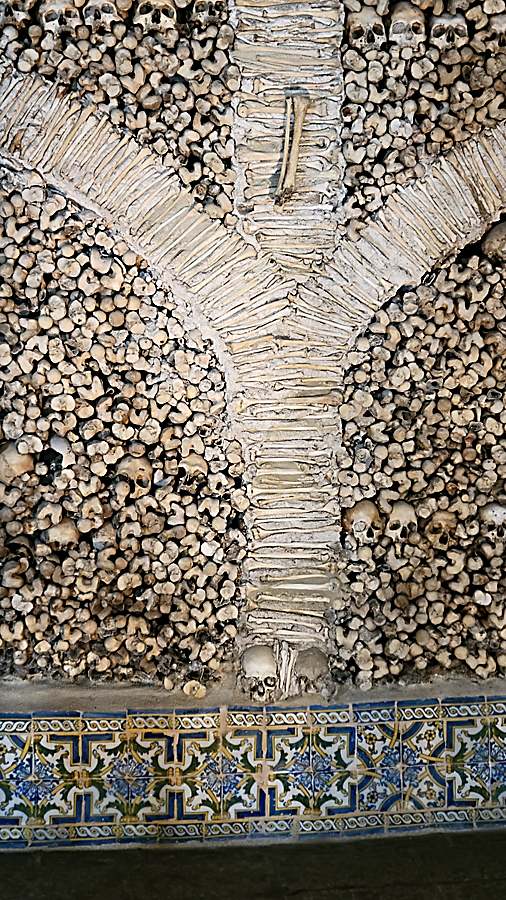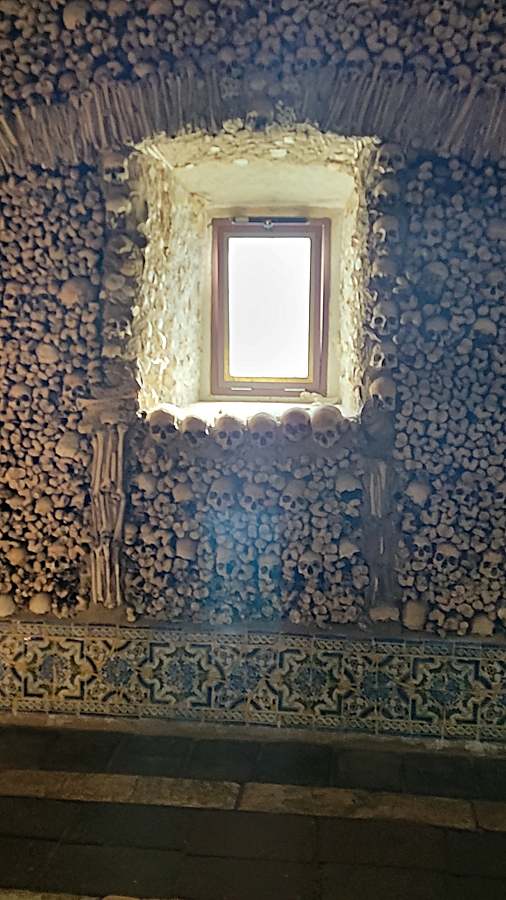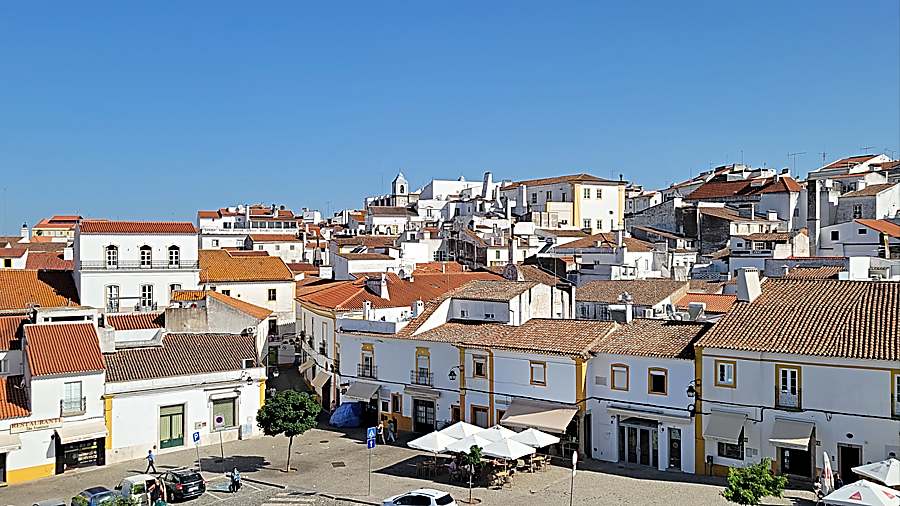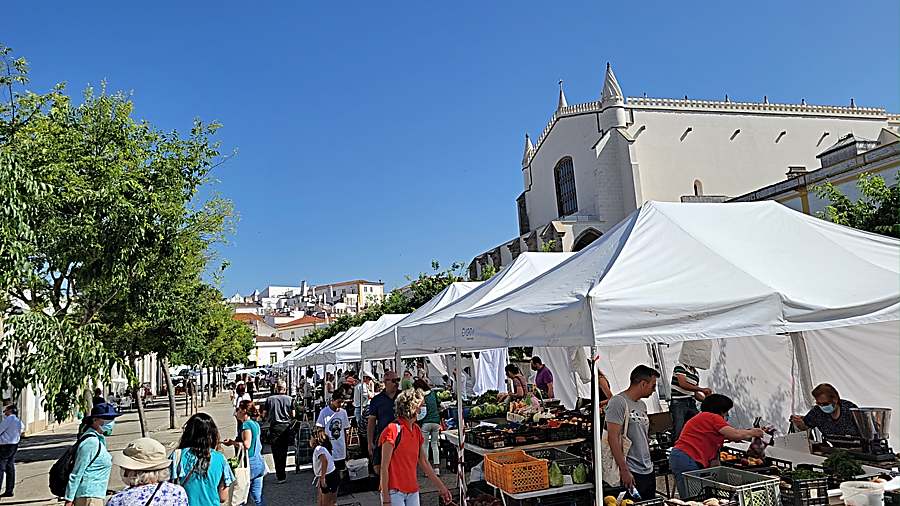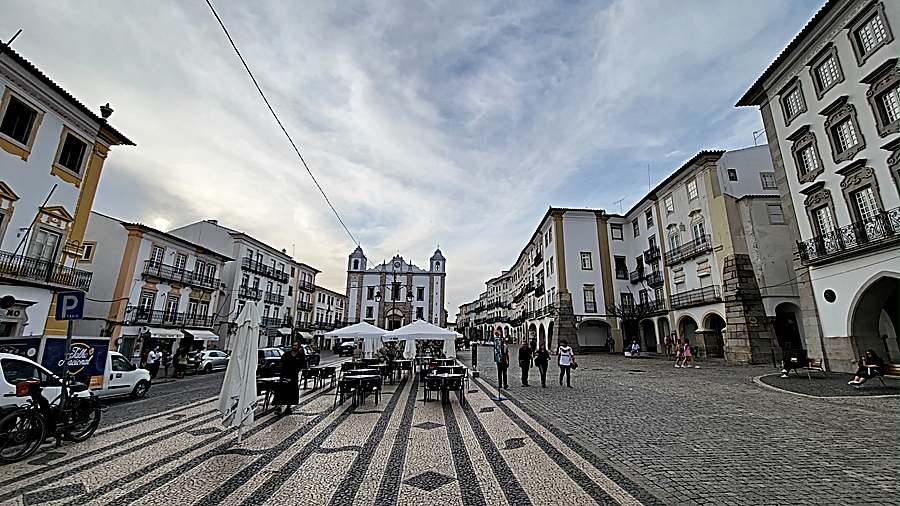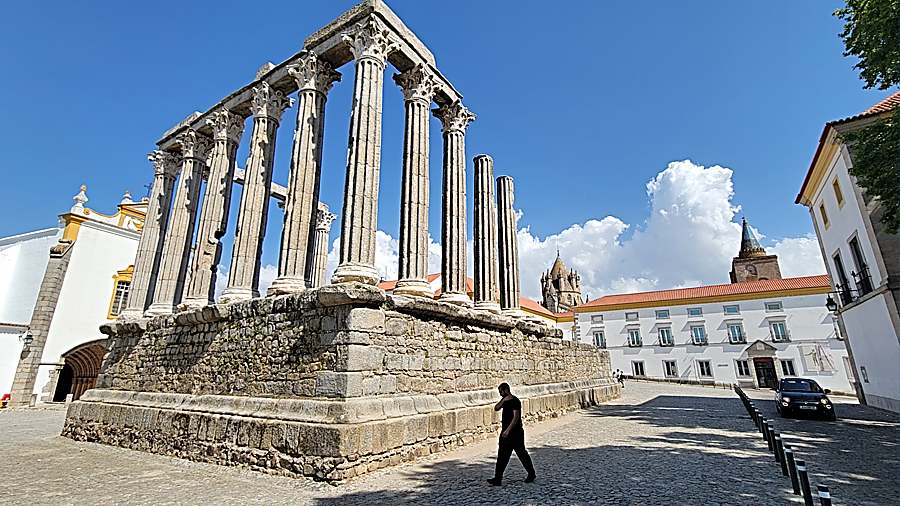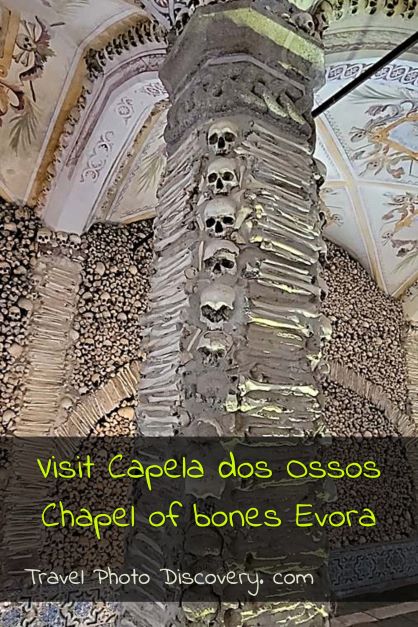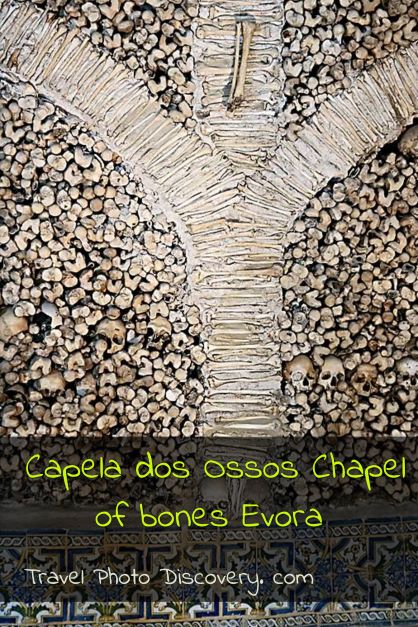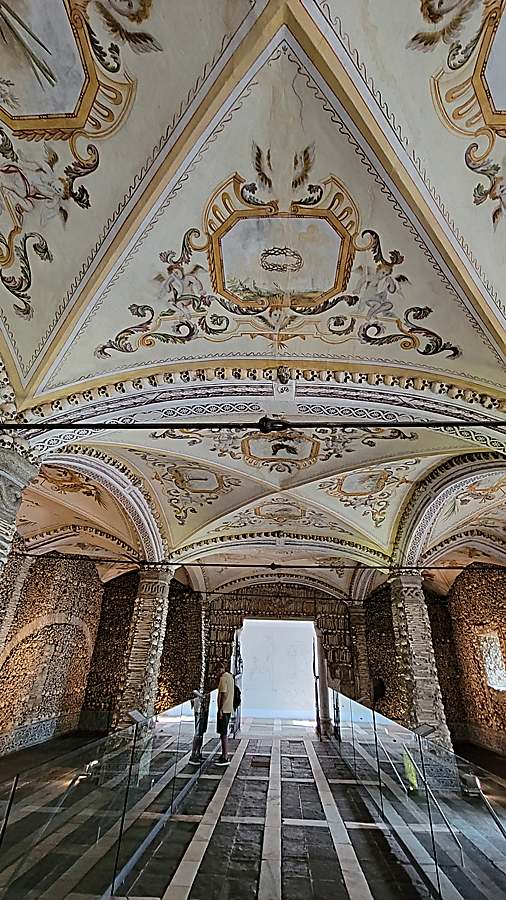Capela dos Ossos Chapel of bones in Evora
In this post, we visit the Capela dos Ossos or the Chapel of Bones in Evora, Portugal and explore the church, museum and art galleries that is part of the complex. You’ll want explore this unusual chapel that served a real purpose for the local community.
The Capela dos Ossos, also known as the Chapel of Bones, is a fascinating and haunting place located in Évora, Portugal. This unique chapel has captivated visitors for centuries with its macabre yet thought-provoking interior, adorned entirely with human bones. Stepping inside the Chapel of Bones is like entering a surreal world where the walls, pillars, and even the ceiling are covered in skulls and bones, creating an eerie atmosphere.
Located within the walls of the Igreja de São Francisco, the Chapel of Bones is a popular tourist attraction in Évora. Visitors from around the world come to witness this macabre masterpiece and delve into its historical and philosophical significance.
Discover the Eerie Beauty of Capela dos Ossos – the Chapel of Bones in Évora, Portugal
Everyone who thinks this may be a gruesome and strange chapel that is a key attraction in the UNESCO city of Evora, but it has a fascinating history. It really is a must visit site in Evora not just for the curiosity factor but for the wonderful way they actually celebrate the past and innovation of presenting this chapel of bones.
For those that think this is a creepy attraction to visit, it’s not and a worthwhile site to see in the historic district of Evora.
Why visit the Capela dos Ossos at Evora
Visiting the Capela dos Ossos in Évora, Portugal, is a truly unique experience. This chapel, constructed in the 16th century by Franciscan monks, is famous for its walls lined with human bones and skulls. Despite its macabre interior, it offers historical significance, encouraging deep contemplation about life and death. The chapel’s architecture and bone-adorned walls create an eerie yet artistically intricate ambiance.
This attraction is part of Évora’s UNESCO World Heritage site and adds a different layer to the city’s rich history. It’s an educational opportunity, shedding light on the cultural practices and beliefs of the past. While the Capela dos Ossos is not for everyone due to its unsettling decor, for those interested in history and the human experience, it provides a memorable encounter with the past.
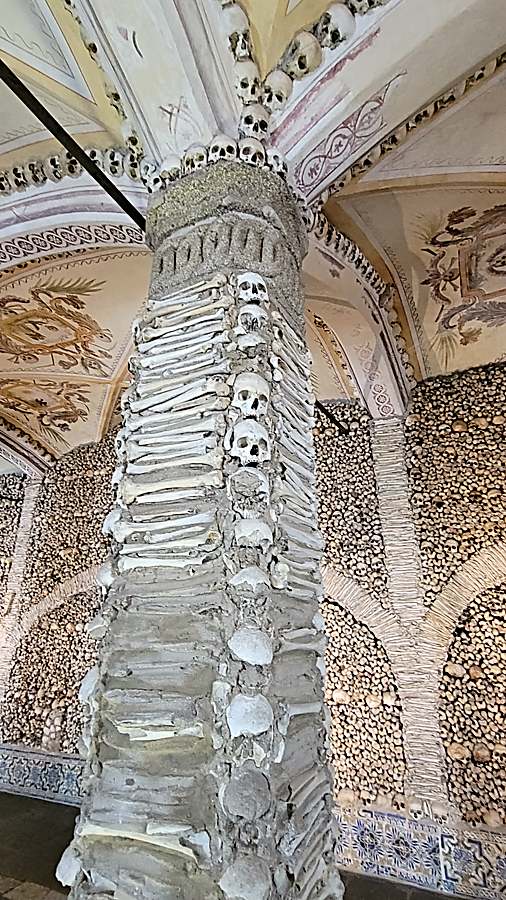
Capela dos Ossos history – History of the chapel
Where is Capela do Ossos located in Evora?
The Capela dos Ossos (Chapel of Bones) is located in Évora, a historic city in the Alentejo region of Portugal. This intriguing chapel can be found within the Church of São Francisco in Évora’s city center in a chapel just off to the side of the basilica.
Capela dos Ossos : Chapel of bones in Evora, Portugal
What to expect from the chapel of bones
The entrance to the chapel of bones truly says it all when you visit, stating “We, the bones that are here await yours”. That is a macabre statement at the start but when you enter the intimate chapel, you are greeted with over 5000 bones that are intricately cemented into place in detailed fashion on the walls, ceiling and overall design of the chapel.
You’ll spot skulls and bones watching you from all angles on the walls, columns to arches and altar piece area in an eerie, provocative and striking display.
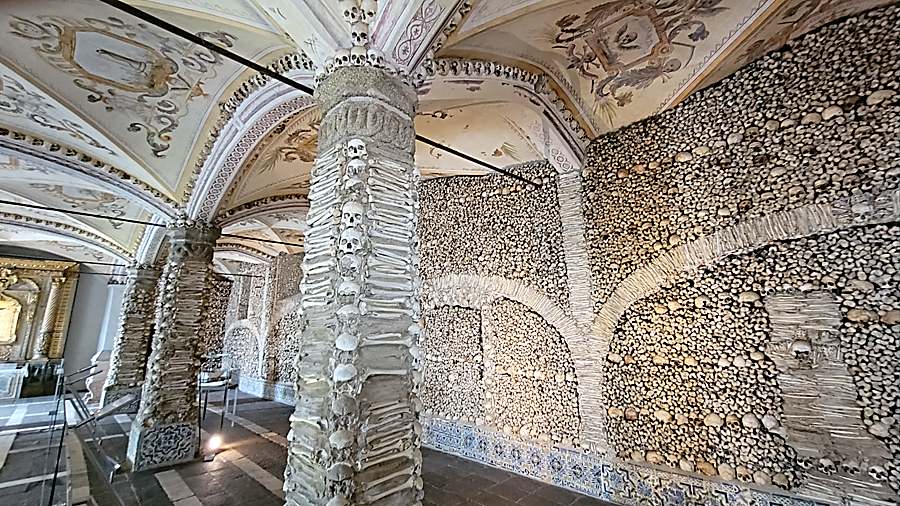
Capela dos Ossos photos -interior details of the chapel
History of Capela dos Ossos, Chapel of bones Evora
The chapel is a small part of the larger Igregia de Sao Francisco – Church of St. Francis which was the royal church of Evora at that time. This large and beautiful Manueline – Gothic church was completed in 1510 and a gorgeous display of beautiful details with the blue azulejo tiles, carved altar with golden inlays, statuary and paintings.
The chapel sits next door to the main church and was built in the 16th century with the bones exhumed from local graves in town. Taking up much valuable space around the city, the bones were taken out and the monks built this beautiful chapel and relocate the bones. The chapel was created to showcase the importance of societies values and collection of materials and wealth and to contemplate life and death in this space.
Weather and best time to visit the Chapel of Bones in Evora
Évora, where the Chapel of Bones is located, experiences a Mediterranean climate with hot summers and mild winters. Here’s some information about the weather and the best time to visit the Chapel of Bones in Évora:
Summer in Évora, from June to August, can be quite hot with average temperatures ranging from 77°F to 93°F (25°C to 34°C). The city tends to be crowded with tourists during this time, and the Chapel of Bones may have long queues. If you can handle the heat and crowds, visiting in summer allows you to explore the rest of Évora’s attractions in pleasant weather.
Spring (March to May) and autumn (September to November) are generally the best times to visit the Chapel of Bones. During these seasons, the weather is mild, with temperatures ranging from 57°F to 77°F (14°C to 25°C). The city is less crowded, allowing for a more serene and immersive experience inside the chapel.
Winter (December to February) in Évora brings cooler temperatures, ranging from 41°F to 61°F (5°C to 16°C). While the city might be quieter during this time, visiting the Chapel of Bones in winter can provide a more intimate atmosphere and fewer tourists to navigate.
It’s important to note that the Chapel of Bones is an indoor attraction, so you can visit it year-round regardless of the weather. However, considering the weather conditions outside the chapel, spring and autumn offer a comfortable climate for exploring Évora’s other outdoor attractions and enjoying the overall experience.
To make the most of your visit to the Chapel of Bones, it’s advisable to check the opening hours in advance and consider visiting during weekdays or early in the day to avoid potential crowds.
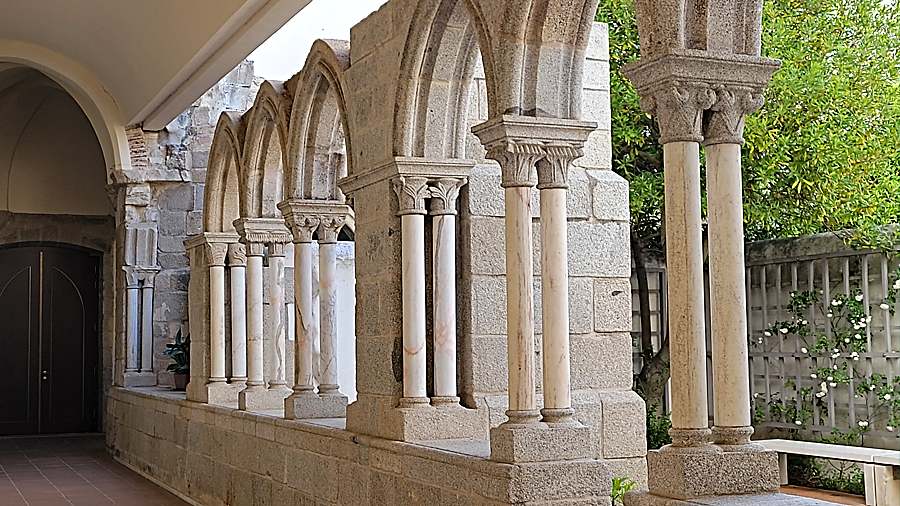
Capela de Ossos – the cloister area
How to get to Capela dos Ossos – the Chapel of Bones in Évora
When you are in Évora and want to find the Chapel of Bones (Capela dos Ossos), you can follow these directions:
Évora’s Historic Center: The Chapel of Bones is located within the historic center of Évora. Start by exploring the charming streets and landmarks of the city’s old town.
Navigate to Praça do Giraldo: One of the main squares in Évora is Praça do Giraldo. You can make your way to this bustling square, which serves as a central point for navigation.
Locate the Church of St. Francis: From Praça do Giraldo, head towards the Church of St. Francis (Igreja de São Francisco). The church is an important landmark and is often marked on maps and signs.
Entrance to the Chapel of Bones: Once you reach the Church of St. Francis, you will find the entrance to the Chapel of Bones within the church premises. Look for signs or ask locals for directions if needed.
Explore the Chapel: Enter the Chapel of Bones and prepare to be amazed by its unique and eerie atmosphere. The chapel is adorned with human bones and skulls, creating a thought-provoking and solemn environment.
It’s worth noting that Évora is a compact city, and most of its attractions, including the Chapel of Bones, are within walking distance in the historic center. Take your time to soak in the beauty of Évora’s streets and landmarks as you make your way to this fascinating and haunting chapel.
Entrance to the church and chapel of bones
The entrance to the beautiful church of San Francisco is free to explore the gorgeous interior. There is an entrance fee to see the chapel of bones. You enter to the right side of the church through a courtyard area to the ticket office.
Entrance fee
The Chapel of bones entrance fee is 5 Euro for adults, 3.5 Euro for ages under 25 or over 65 years.
Entrance includes a visit to the museum upstairs, collections and a fantastic view of Evora outdoors from the terrace
What to see inside the Chapel of bones
Surprisingly the interior of the chapel of bones is not as macabre and scary as you might have expected. Housed in a small and bright chapel, you might not see the bones initially well designed into the walls and details with colorful ceilings and painted details that might lead you to think it was a nice chapel.
Then you will instantly see more details to seeing that the walls and columns feature the skulls and bones of the exhumed bones from the area.
Cemented into place, the bones are designed into intricate patterns and displayed on the walls and then columns. Also, In the ornate painted ceilings, skulls line the archways in detailed lines as accent pieces to the painted surfaces
In the glass coffins are the remains of two children sleeping peacefully in these coffins.
A memento to life and death
Visitors to this chapel are really given the intent to contemplate the meaning of life and death with this presentation. This is what the original purpose of the building of this little chapel and if you take the time to read the details, you’ll understand the profound message.
What else to see at Capela dos Ossos, Chapel of bones Evora
Visit the upstairs museum area
Upstairs is a museum portion to the visit with various galleries showing paintings, murals and other collections of Evora and its historical and royal patronage. There’s also a temporary exhibit space and at the time of visit included an amazing collection of Jesus crèche in wood, ceramics, mosaics and other cool materials.
Fantastic views of Evora
There’s also an outdoor terrace you can visit with fantastic views of Evora from above worth the visit alone.
Revolving show
There’s a revolving show in some of the additional galleries to visit around the museum. At the time of my visit there was a show on all the Creche displays of the world.
Church of Saint Francis (Igreja de São Francisco)
The Church of Saint Francis, located in Évora, Portugal, is a historic and architecturally significant religious site. Also known as Igreja de São Francisco in Portuguese, it is one of the most prominent landmarks in the city. The church is situated next to the chapel of bones which is a part of this grand church in Evora.
Here’s a description of the church:
Exterior: The Church of San Francisco is an imposing Gothic-style structure with a blend of Manueline and Baroque architectural elements. Its facade is adorned with intricate stonework, featuring elaborate carvings and statues of saints and biblical figures. The main entrance is adorned with an ornate portal, displaying the craftsmanship of the period. The exterior reflects the rich history and religious importance of the church.
Interior: Upon entering the church, visitors are greeted by an awe-inspiring interior filled with stunning details and religious artwork. The church’s interior is particularly renowned for its remarkable Chapel of Bones (Capela dos Ossos), which is one of its most unique and haunting features. The Chapel of Bones is a small chapel located within the church, entirely covered with human bones and skulls. This macabre yet thought-provoking chapel was created by Franciscan monks in the 16th century as a reminder of the transience of life and the inevitability of death.
The main nave of the church is characterized by high vaulted ceilings with beautiful ribbed arches, typical of Gothic architecture. Throughout the interior, visitors can find various religious paintings, sculptures, and altarpieces, showcasing the Baroque influence in the church’s decoration.
Cloister: Connected to the church is the serene and elegant Cloister of the Church of San Francisco. The cloister features a harmonious combination of Gothic and Manueline styles. Its arches are intricately decorated with delicate carvings of botanical motifs, symbols, and religious figures. The cloister provides a peaceful atmosphere and is a wonderful place for contemplation and reflection.
Details to visiting the Capela dos Ossos
Address: Praça 1º de Maio 4, 7000-650 Évora, Portugal
Hours – Friday to Thursday 9am to 6:30pm
Other things to see around Evora
There’s plenty of places to explore around this basilica and the central district around Evora: FInd out all these fascinating places to visit below:
Visit the city center Evora Market and public market days
Held on Saturday mornings in the square fronting the Evora Palace, the daily market of Evora has the various produce, fresh fruit, meats and other delicacies in tents in the outdoor section. There is also a daily market with stalls in the same area for more specialty food products and stalls selling regional prepared foods and artisanal products for sale from the region.
Giraldo Square in Evora
The grand main square in the central district of Evora, Giraldo square fronts the basilica of St. Andrew. Named in honor of Giraldo the Fearless who defeated the Moors in 1165 and was made the governor of Evora, the square was a former Roman market and eventually renamed in his honor.
The beautiful fountain at the plaza draws its water originally from the aqueduct where fresh water was sourced directly to this fountain for the public to use in ancient times.
Templo Romano Evora
Located in a prominent square in the old town this historic Roman Temple is dedicated to the cult of Augustus is and one of the finest examples of Roman temples located in the Iberian country.
Situated on an elevated platform the temple consists of 14 columns and was incorporated into a slaughter house, a royal palace and eventually turned into a historic monument on its own.
Many locals call this the Temple of Diana which is different than the actual dedication because of a legend during the 17th century of this temple being dedicated to the goddess of hunting. This has lead to naming this site the templo Romano of Evora to not confuse visitors to this historic attraction.
How to get to Evora, Portugal
Évora, Portugal, can be reached by various modes of transportation. Here are some common ways to get to Évora:
By Air: The nearest major airport to Évora is Lisbon Portela Airport (LIS). From Lisbon, you can take a direct train or bus to Évora. The airport offers numerous international and domestic flights, making it a convenient entry point for travelers. Once you arrive in Lisbon, you can choose from various transportation options to reach Évora.
By Train: Évora has a train station connected to the national railway network. Regular train services operate between Lisbon and Évora, with the journey taking around 1.5 to 2 hours. Trains also connect Évora to other major Portuguese cities, such as Porto and Faro. It’s advisable to check the train schedules in advance and book your tickets accordingly.
By Bus: Several bus companies provide transportation to Évora from various cities in Portugal. Rede Expressos is a popular bus company that offers comfortable and reliable services. Buses generally have multiple departures throughout the day, allowing flexibility in planning your trip.
By Car: Évora is easily accessible by car. If you’re driving from Lisbon, you can take the A2 highway towards Évora, which is approximately a 1.5-hour drive. Car rental services are available at Lisbon Portela Airport and in downtown Lisbon, offering flexibility for exploring the region at your own pace.
Once you arrive in Évora, the city is relatively compact and can be easily explored on foot. Public transportation, such as buses and taxis, is available within the city for convenient transportation to specific attractions or areas.
Check out these posts to visiting Evora
Explore the surrounding countryside and attractions in Alentejo
Traditional Portuguese dishes to enjoy
Pin and save this for later
Getting around Evora, Portugal
Getting around Évora, Portugal, is a pleasant experience, as this charming city is relatively compact and pedestrian-friendly. Here are some convenient ways to explore Évora:
1. **Walking**: Évora’s historic center is best explored on foot. Stroll through narrow cobbled streets, discover hidden squares, and admire the well-preserved architecture.
2. **Bicycles**: Renting a bicycle is a great way to explore the city and its surroundings. Évora has dedicated bike lanes and bike-friendly streets.
3. **Tuk-Tuks**: These small, motorized vehicles offer guided tours of Évora, providing an informative and fun way to see the city’s attractions.
4. **Public Transportation**: Évora has a local bus service that connects different parts of the city. Look for bus stops and routes to reach specific destinations.
5. **Taxis**: Taxis are readily available in Évora and can be a convenient way to reach destinations outside the city center.
6. **Car Rentals**: While not necessary for getting around Évora itself, renting a car can be useful if you plan to explore the surrounding Alentejo region.
7. **Guided Tours**: Joining guided walking tours can provide you with insights into the city’s history and culture while helping you navigate its streets.
8. **Maps and Apps**: Use maps and navigation apps on your smartphone to help you find your way around Évora and locate specific attractions.
9. **Local Knowledge**: Don’t hesitate to ask locals for directions or recommendations. They can provide valuable insights into the city’s hidden gems and lesser-known attractions.
10. **Parking**: If you have a car, be aware that parking in the city center can be limited. Look for designated parking areas and garages.
Évora’s compact size makes it easy to explore on foot, and this method allows you to fully immerse yourself in the city’s rich history and culture. Whether you choose to walk, cycle, or take a guided tour, Évora offers a delightful blend of architectural wonders, historical sites, and a relaxed pace of life.
Final thoughts
Don’t be afraid to visiting the Capela dos Ossos and use this as an educational experience to understand the history, culture and inventiveness of the early monks that created this impressive chapel.
Conclusion to visiting the Capela dos Ossos, Chapel of bones in Evora
A visit to the Chapel of Bones in Évora, Portugal, promises a unique and captivating experience that will leave a lasting impression. This extraordinary place, adorned entirely with human bones, offers a thought-provoking journey into the depths of human mortality and contemplation.
The Chapel of Bones is not merely a macabre display, but rather a poignant reminder of the transient nature of life. Stepping inside, you’ll be immersed in an atmosphere that encourages introspection and reflection on the passage of time and the inevitability of death.
Thanks for visiting today and checking out this post on the Capela dos Ossos, Chapel of bones in Evora. If you enjoyed the images and post, could you please share it with any of the social media buttons located around the post.
If you like what you see, come and check out my other social media channels for more updates, including Instagram, Pinterest and Twitter
Disclosure – There are affiliates links on these posts which provide a small commission to support this site at no extra cost to you. Thank you for reading, and happy travels

